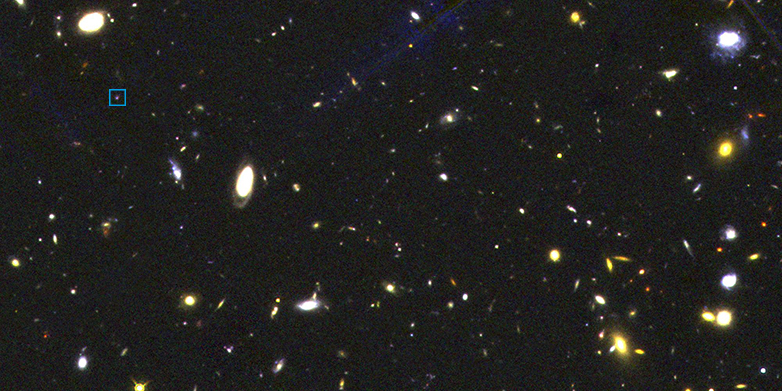Galaxies used to play by different rules
ETH researchers studying how stars are formed in distant galaxies have made an unexpected discovery: a correlation that exists today between the proportion of heavy chemical elements in a galaxy and the rate at which new stars are formed in this galaxy did not apply 10 billion years ago. This observation helps scientists understand how galaxies with their stars and planets were formed over billions of years.
"The universe has been constantly evolving ever since the Big Bang 13.7 billion years ago and has looked different in every epoch, which is incredibly fascinating," explains Marcella Carollo, Professor for Astrophysics at ETH Zurich. Her research group studied galaxies that are more than 10 billion light years away from us, allowing them to get a glimpse of the early universe just 3 billion years or so after the Big Bang. This epoch is particularly interesting because many stars were born at that time – more than ever before or afterwards. "In today’s Milky Way, one or two stars are formed each year. 10 billion years ago, it was probably around 200 suns per year in such a galaxy," says the astrophysicist.
Large, massive stars have a short lifetime in cosmic terms. They die around 10 million years after they were born, exploding as supernovas and hurling matter, including oxygen, into the surrounding gas. "That’s exactly what we measured in our work," explains Masato Onodera, who was a member of the ETH research group until recently and now works at the Japanese Subaru Telescope on Hawaii. He is lead author of the study, which has now been published in The Astrophysical Journal.
Births and 'metals' are not connected
The team observed 41 distant galaxies and calculated the proportion of their elements that were heavier than hydrogen and helium. In astronomy, these heavy elements, including oxygen, are called 'metals' (as opposed to chemistry, for example, where metals must have a high electrical conductivity). Heavy metals are what enabled the formation of planets which orbit the stars. We too are made from 'astronomic metals'.
The researchers demonstrated that galaxies such as our own Milky Way contained far less metals in the early universe than present-day star systems, with a comparable metallicity of around just 20%. But this fact alone did not astonish the researchers.
They were instead surprised to discover that a well-known correlation was missing: in today’s universe, astronomers can predict the metallicity in a galaxy once they know how many stars are formed in the galaxy each year. Today’s galaxies with a high rate of star births contain fewer metals than those with less active star formation. "When we looked at the early universe of 10 billion years ago, this correlation disappeared," says Onodera. "There is no connection between the rate at which stars were born in an earlier galaxy and the amount of heavy elements it contains."
The bathtub model
"The findings on metallicity provide us with important clues into the physical balance of galaxies over epochs and the formation of stars and planets," says Marcella Carollo. There are many theories, but it’s only with such observations that we can work out which of them are correct.
The astrophysicist compares the galaxies with machines, in which outside gas, mainly hydrogen, flows inside like water in a bathtub. The gas acts like a reservoir from which stars are formed, but a part is ejected again. "To understand this machine and find out why it has become increasingly slow over the last 10 billion years, we have to know the metallicity," says Marcella Carollo. This is because the proportion of heavy metals is the result of complex interactions between the incoming and outgoing gas and the star formation.
Measurements in Hawaii
The glimpse into the past was made possible thanks to the Keck giant telescope and its 10-metre mirror on Mauna Kea in Hawaii. It not only provides images of distant, extremely faint objects, but also spectra, which make it possible to draw conclusions about existing chemical elements. Due to the strong redshift of the light, spectral lines are found in the infrared range and are very difficult to prove. A newly installed infrared spectrograph made it possible for the researchers to observe several objects at the same time, allowing them to collect data extremely efficiently.
"Securing the desired telescope time required some diplomatic skills," says Marcella Carollo. Thanks to Masato Onodera from Japan, some of the observations could be carried out as part of an exchange programme between the American Keck Observatory and the Japanese Subaru telescope in Hawaii, while Marcella Carollo drew on her good relationship with the California Institute of Technology, co-owner of Keck. "Our work was thus a wonderful joint effort," says the astrophysicist.
Reference
Onodera M, Carollo CM, Lilly S, Renzini A, Arimoto N, Capak P, Daddi E, Scoville N, Tacchella S, Tatehora S, Zamorani G: ISM excitation and metallicity of star-forming galaxies at z~3.3 from near-IR spectroscopy, The Astrophysical Journal, 3 May 2016, doi: external page 10.3847/0004-637X/822/1/42

Comments
No comments yet